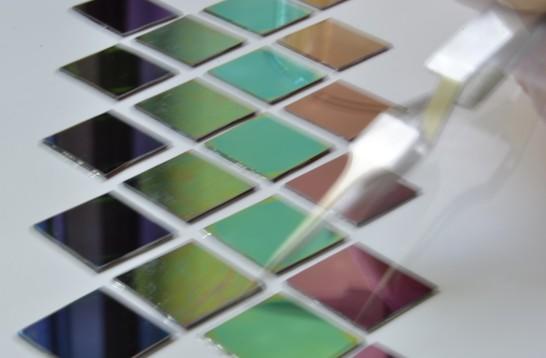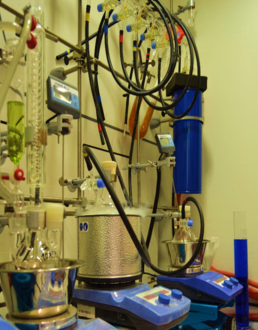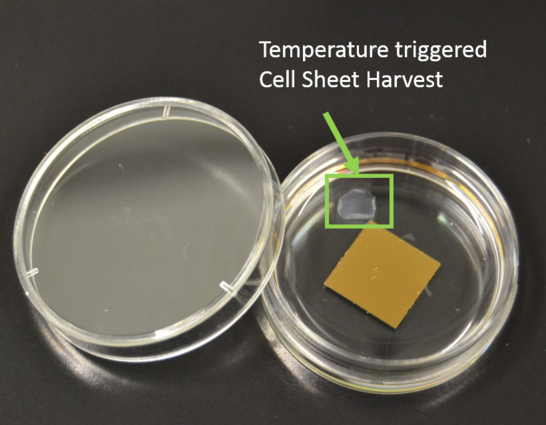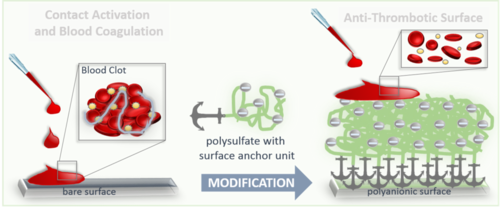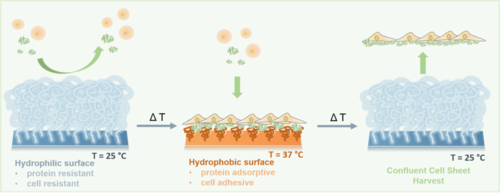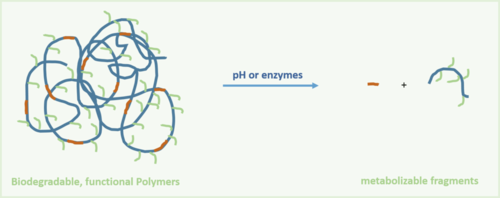Research
Research Interests
Our research interests are located in the biomedical field combining surface science, polymer synthesis and tissue engineering.
SURFACES
|
SYNTHESIS
|
TISSUE ENGINEERING
|
Research Topics
Antithrombotic Surfaces
Fig. 1. Activation of blood coagulation and resulting blood clot formation by contact of blood with bare surfaces and prevention of blood coagulation by surfaces modification with polyanions resulting in anti-thrombotic surfaces.
Within the so called intrinsic pathway of blood coagulation, clotting is initiated by contact with surfaces and materials that are foreign to the body. In order to prevent blood clotting and subsequent thrombus formation, blood contacting surfaces for biomedical applications are modified. A typical approach involves a surface coating with heparin which is a naturally occurring polysulfate with strong anticoagulant properties. Alternatively, neutral, protein-resistant polymers are also effective in suppressing thrombus formation. We are currently investigating antithrombotic surfaces made of anticoagulants with defined anchor functionalities for a universal, substrate-independent and covalent surface immobilization and modification. This project is a part of a collaboration with Dr. Rainer Haag at Freie Universität Berlin, Dr. Jens Dernedde at Charité Berlin and Dr. Jay Kizhakkedathu at the Center for Blood Research at the University of British Columbia, Vancouver, Canada. Funding is currently provided through the Focus Area NanoScale of the Freie Universität Berlin.
We are grateful to the Focus Area NanoScale of FUB for financial support.

Thermoresponsive surfaces
Fig. 2. Temperature triggered cell adhesion, proliferation and detachment on/from thermoresponsive surfaces.
Thermoresponsive polymers with a lower critical solution temperature (LCST) are soluble below this temperature and become insoluble once heated above this temperature. Such phase transitions are not limited to solution but also occur when the polymers are tethered to surfaces. The observed phase transition is accompanied by a change of hydrophilicity of the polymer and the modified surface. A temperature-triggered switchability of the surface between a relatively hydrophilic and protein-resistent state and a more hydrophobic, protein adsorbing state is obtained. Since mammalian cell adhesion on surfaces is a protein-mediated process such thermo-switchable surfaces can be used to trigger cell adhesion and detachment. This allows for the fabrication and mild harvest of confluent cell sheets with their extracellular matrix (ECM). In conventional cell culture, cells are singularized during the harvesting process by enzymatic dissolution of their ECM. Otherwise, confluent cell sheets are only accessibly by mechanical scratching of confluent sheets off the surface. Such harsh procedures have been shown to harm the extracellular matrix and cell surface proteins of the harvested cells sheets.
This project is financially supported by the Federal Ministry of Education and Research (BMBF, FKZ 13N13523) within the WING program by the young academics competition "NanoMatFutur".

Cell Sheet Engineering
Fig. 3. Scaffold-free tissue engineering. 3-D Arrangement of confluent cell sheets for the fabrication of 3-D tissue without the need for scaffolds.
So-called cell sheet engineering is a scaffold-free tissue engineering approach towards three-dimensional tissue. Confluent cell sheets are a prerequisite to this technique which was developed in Japan by T. Okano and coworkers. The thickness of such tissue constructs in general is limited to 150-200 µm due to the lack of blood vessels which ensure the supply with nutrients and oxygen as well as the removal of metabolic waste. We are currently pursuing several approaches towards vascularized tissue in vitro in order to generate thick 3-D tissue constructs which will be evaluated as a replacement model to conventional animal tests in organ-specific toxicity assessment of new drugs and materials.
This project is financially supported by the Federal Ministry of Education and Research (BMBF, FKZ 13N13523) within the WING program by the young academics competition "NanoMatFutur".

Biodegradable, functional Polymers
Fig. 4. Biodegradable and biocompatible polymers which can be degraded by pH or enyzmes yielding low molecular weight, non-toxic fragments that can be easily metabolized by cells.
We are aiming at biocompatible, functional polymers that are degradable in vitro in the presence of cells either by pH or enzymes. Therefore, labile groups are incorporated into the functional polymer at various concentrations and the resulting degradation times under standard cell culture conditions are investigated. Thereby, different labile groups are tested in order to optimize the resulting polymer for its rate of degradation as well as the resulting biocompatibility of the generated low molecular weight fragments after degradation. In the ideal case, these resulting low molecular weight fragments are readily metabolized by cells.
This project is financially supported by the Federal Ministry of Education and Research (BMBF, FKZ 13N13523) within the WING program by the young academics competition "NanoMatFutur".


